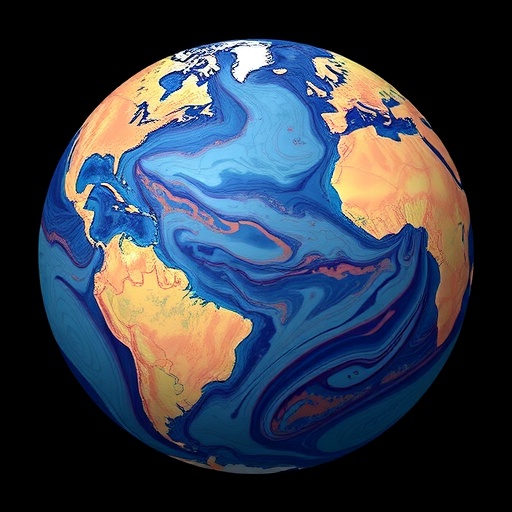In a groundbreaking advancement for oceanographic science, researchers have unveiled a refined methodology to quantify surface eddy meridional heat transport (EHT) induced by mesoscale eddies. Published recently in Science China Earth Sciences, the study adeptly combines Eulerian and Lagrangian analytical frameworks to disentangle the complex physical processes contributing to heat redistribution in the world’s oceans. This approach not only clarifies the relative contributions of stirring and trapping mechanisms by mesoscale eddies but also fundamentally enhances the precision of heat transport estimates essential for climate modeling.
Mesoscale eddies, swirling oceanic features typically spanning tens to hundreds of kilometers, play a critical role in the lateral transport of heat, salt, and nutrients within the upper layers of the ocean. These eddies operate on timescales ranging from weeks to months and are pivotal in modulating regional and global ocean circulation patterns. Despite their recognized importance, accurately quantifying the heat transport associated with eddies has been a persistent challenge due to the complex interactions between fluid dynamics and thermodynamic processes.
Central to the study is the novel integration of two contrasting yet complementary approaches: the Eulerian perspective, which examines fluid flow at fixed points in space, and the Lagrangian viewpoint, which traces the movement of individual fluid parcels over time. Traditionally, these methods have been applied separately, limiting the capacity to fully resolve the intricate pathways by which eddies affect meridional heat transport. By synergizing these frameworks, the research team devised a robust computational model that captures both the stirring—horizontal deformation and filamentation—and trapping—coherent fluid parcel retention—effects imparted by mesoscale eddies.
The results reveal a striking disparity in the magnitude of heat transport mechanisms. Specifically, the stirring-induced surface EHT is found to be one to two orders of magnitude greater than that generated by trapping across the majority of the global ocean. This indicates that the dominant influence of mesoscale eddies lies in their ability to horizontally stir and redistribute heat rather than merely trapping and transporting heat-rich water masses in coherent eddy cores.
Furthermore, this enhanced understanding challenges previous assumptions that emphasized the significance of coherent eddy trapping as a primary driver of eddy-associated heat fluxes. The study’s findings suggest the horizontal stirring effect—characterized by intense stretching and folding of oceanic fluid parcels—facilitates more extensive and efficient heat dispersion on basin-wide scales. This revelation has profound implications for improving parameterizations of eddy-induced transports in both regional and global ocean models.
The methodological advances underlying this work include novel algorithms that merge Eulerian velocity field measurements with Lagrangian trajectory analysis derived from satellite data and autonomous float observations. The researchers incorporated sophisticated statistical tools to delineate coherent eddy boundaries and accurately quantify the contribution of these structures to meridional heat transport. The interdisciplinary nature of the approach bridges physical oceanography, computational fluid dynamics, and applied mathematics, emphasizing the growing complexity of modern climate research.
By resolving disparate contributions of stirring and trapping, the research offers a refined lens through which to interpret mesoscale eddy dynamics. It also underscores the necessity of accounting for the multifaceted role of turbulence and coherent structures in modulating oceanic heat pathways. Such insights are particularly relevant as climate models increasingly rely on subgrid-scale parameterizations to represent mesoscale processes that cannot be fully resolved at global scales.
In the context of Earth’s energy budget, these findings contribute significantly to the understanding of how heat is redistributed from the equator toward higher latitudes by ocean circulation. Since mesoscale eddies constitute one of the primary sub-surface mechanisms transporting heat meridionally, accurate quantification of their transport capabilities is crucial for predicting climatic feedbacks and the evolving patterns of ocean-atmosphere interaction under global warming scenarios.
Beyond scientific implications, the newly developed combined Eulerian-Lagrangian framework offers a powerful tool for operational oceanography. Improved forecasting of mesoscale eddy activity and associated heat transport could enhance weather prediction, climate variability assessments, and marine resource management. The methodology’s adaptability allows for assimilation into Earth system models, potentially leading to more reliable simulations of ocean heat content changes.
Moreover, the study’s comprehensive global analysis, spanning diverse oceanic basins, provides an unprecedentedly detailed picture of mesoscale eddy behavior under varying physical conditions. This broad applicability affirms the universality of the stirring mechanism’s dominance and invites further investigations into regional deviations or temporal variability linked with climatic oscillations such as the El Niño-Southern Oscillation or the Atlantic Multidecadal Oscillation.
The research marks a pivotal step forward in oceanographic science by elucidating the fundamental processes governing mesoscale eddy contributions to surface heat transport. As the global climate system continues to evolve, understanding the precise mechanisms that regulate ocean heat distribution becomes even more critical. This study equips scientists and modelers with enhanced conceptual and computational resources to address the pressing challenges of climate prediction and ocean system dynamics.
In conclusion, the integration of Eulerian and Lagrangian methodologies to dissect stirring and trapping effects represents a technical and conceptual breakthrough. The clarified dominance of horizontal stirring in mesoscale eddy-induced surface EHT has far-reaching consequences for the future of climate modeling, ocean observation, and our overall grasp of Earth’s complex heat transport systems. This research not only advances scientific knowledge but also propels the field toward more sophisticated frameworks for studying turbulent processes in geophysical flows.
Subject of Research: Oceanographic quantification of surface eddy meridional heat transport induced by mesoscale eddies
Article Title: Not provided
News Publication Date: Not provided
Web References: Not provided
References: Publication in Science China Earth Sciences (specific citation not provided)
Image Credits: Provided by EurekAlert! via Science China Earth Sciences
Keywords: Mesoscale eddies, surface eddy heat transport, oceanography, Eulerian method, Lagrangian method, meridional heat transport, stirring effect, trapping effect, ocean heat distribution, climate modeling, ocean circulation, fluid dynamics




